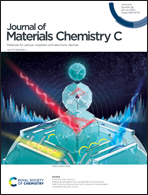Mottness collapse in monolayer 1T-TaSe2 with persisting charge density wave order†
Abstract
Single-layer 1T-TaSe2 has recently been found to host a Mott insulating ground state entwined with a commensurate charge density wave (CDW). However, the interplay between the CDW order and the Mott state remains unclear and elusive. Using first-principles calculations, we show that the CDW order with Star of David lattice distortions induces the formation of two different types of Ta-d orbitals (one is localized and the other is extended), and the Mott insulating state is brought on by the electron correlation in the localized orbital which is separated from the extended orbitals in energy. Interestingly, when a compressive biaxial strain is applied on monolayer 1T-TaSe2, the Mott insulating phase will first transform into a charge-transfer insulating phase and then into a normal metallic phase with increasing strain. The CDW always persists and is even enhanced under the strain, indicating that the Mottness collapse is unexpectedly not at the expense of suppression of the long-range CDW order. We further reveal that the realization of metallization in the CDW phase occurs because the localized orbital is immersed into the extended-orbital-spanned Fermi sea and its Hubbard splitting is quenched by orbital hybridization. Our findings may provide significant implications for fine control over correlated electronic states, possessing potential applications in ultrafast resistive switching.



 Please wait while we load your content...
Please wait while we load your content...